The article covers a visit to one of the top 3 systems I have heard, based on a TAD 4003 dual woofer FLH, entirely DIYed. The article discusses the attributes of beryllium, of TAD 4003, Leif’s approach and philosophy and experience. I stay light on the nitty gritties of DIY to avoid turning this into a DIY thread. It has many videos and those who don’t appreciate videos can make sense reading through, though the videos add to the context. Videos are for context to be read with the text, so judge by the written description. Thanks. Apologies it is long and can be done in parts
Dual Woofer FLH background:
I have been on regarding dual woofer front loaded horns (FLH) for a while now. I had heard a replica of JBL 4560 4 years ago, followed by dual 18 inch FLH made by Silvercore (covered here) and Misho’s dual 15 Altec 817 (covered here).
Western Electric, as usual, set the trend around a 100 years ago with a 4-woofer FLH, the Mirrophonic, which those (including me) that visited Munich in 2017 were blessed to hear. RCA had the Shearer horns, and Altec and JBL followed into the 50s onwards with 817/211 and 4560 respectively. JBL also had a 4-woofer T550a that I have not heard. All these horns were used in theaters to address large audiences with amps of those times, low watt valve amps.
My liking for dual FLH is simple – it does the most coherent, potent, well-timed, and musically detailed midbass, and is best at integrating the midbass with the upper mids and the lower bass, which is the Achilles heel of most speakers. Quads, Martin Logans, many other horns, Apogees, Zellaton, YG, all are capable of producing quality upper mids and highs with nice soundstage. No speaker except a good FLH get the midbass and the integration through it correct. Most of them get by despite their defects, e.g Martin Logan hybrids are great examples – I like them, but they get by despite their weakness. Speakers are either lean or fat (classic example of fat is Wilson or Focal) in the midbass area, and often their woofers have a different design, impedance, sensitivity or dispersion to the rest of the speaker that you can hear through incoherence. Ever heard speakers that require a lot of power for the lows but not much for the highs, so you cannot get the right amp without underdriving or overdriving?
With a dual FLH, you get a similar, open feeling to that of an open baffle, but because of two large 15 inch woofers per speaker, substantial weight to match the power of cones but without the distortion caused in the bass by closed/ported boxes. A very low QTS for such woofers (powerful magnet with light cone structure and voice coil) allow them to be driven by low watt valve amps with low grip, and with very quick but brief excursion allowing for agility. Makes high excursion cone woofers sound slooow, bloated. The cello, drums, tympani, and integration with the rest of the speaker is phenomenal. Simple crossovers and low watt SETs can easily drive such speakers with minimal loss in the signal thus retaining maximum purity.
I loved the coherence and midbass of the Altec 817, the one issue I had with the Altec upper mids and highs was that while they were pleasant and had a nice tone, they did not have the nuance for violin and the transparency shown by Radian or TAD Beryllium drivers, or by AER.
Check for example any of many violin videos of Tango Fongsmut on Youtube, or the hORNS universum videos on my channel, you will see a high degree of violin nuance even on the mobile. This is a Beryllium trait.
Iron Leif
Therefore, I theoretically thought a Radian or TAD with dual Altec 15 inch woofers could be the ultimate speaker. Enter Iron Leif. I will get to the Iron part when I describe his amp and phono. He had a dual FLH with JBL 15 inch woofers, and the TAD 4003. The crossover point was similar to the Altec 817. I was curious to hear his system, as on paper, it was similar to my theoretical Radian/TAD + Altec woofers.
What confronted me in Norway was a giant horn with three drivers on a passive crossover and an active front loaded gigantic pair of subs. Here are some female vocals to warm you up
Here’s another female vocal with TAD 4001, this time with Luxman m800u, so you can see that TAD mids are liquid clear
Here is Winterreise, a very average pressing on Melodiya but a great performance from the recently departed Peter Schreier with Richter, I prefer this to Dietrich Fischer Dieskau and Gerald Moore, as the latter is too closely miked while the Melodiya presssing on the Schreier is more real. Also, I prefer Richter, as Moore is too much in the background.
Here is some jazz. Notice the delicate transparent nuance
Now, in case you want to see what is special about the dual woofer 15s, listen to the difference here on the below two videos. Listening only a couple of minutes on the first video for the compare should be enough.
You can immediately hear that one is coherent, detailed and integrated. On another, you can hear the disconnect between the top and bottom, different decibel levels jumping out. Based on the video, sure, you can say these are different venues, sources, recordings, etc but I can assure you I hear the same in every conal design as compared to a good dual FLH. The above is just a representation of my findings that I found easy to convey. Apogees would come across potent in the midbass as well as coherent, but would not have the details, tone, and texture in the midbass of the FLH, and quads would be as coherent, but would not have the same weight in the lower sections.
If you visit my Altec Misho write-up, you will hear similar advantages to the dual woofer FLH on the Black Sabbath compared to a cone based system
Breaking down Leif’s sound
To start with, his drivers are of the highest quality. The Western Electric 594 was the first (unique for its time) 4 inch voice coil 2 inch throat driver. Next major development was JBL 375 but with Field Coil turning to Alnico. The late Bart Locanthi was the lead engineer (VP Engineering) for JBL in the 60s to early 70s, and then joined TAD where he was offered unlimited budget to make the best driver he thought possible. TAD 4001 is known to be an extension of Bart’s JBL 375 , but the TAD 4003 was his final design to address the shortcomings in the 4001. The 4003 was the last driver Locanthi made. It is no more produced, and is considered to be a collectible unobtanium in the hifi world. The 4001, on the other hand, continues to be produced (more on sonic differences between 4001 and 4003 later).
The Cessaros, which use various TADs, and the 4001 in their top models, are today the main known commercial brand using all TAD drivers, while the Vox Olympian uses TAD drivers above the Vitavox midrange and for the tweeter – this just shows how the Lansing heritage (Altec, JBL, TAD) with western electric designs continue to dominate the industry even today.
So, what is the sonic signature of TAD? TAD is the leading beryllium driver, the other being a beryllium diaphragm production company (Truextent) that provides its diaphragms for use in other drivers. Users of Radian (hORNs Universum), JBL, and a few others buy Be diaphragms from Truextent.
So what is special about Beryllium? After Takajo San, a hifi and music critic joined Goto in the 60s, he led the R&D at Goto to record acoustic instruments live and to try and reproduce them through Goto drivers. Listening, rather than measurements, was his style. Goto’s R&D went down this road, and ended up changing their aluminum diaphragms (then the most widely used in Altec, JBL, Goto etc) to titanium. After that, Takajo San started recording sounds of chirping insects and other sounds from nature to test his drivers. This effort to reproduce sounds of nature led Goto to develop Beryllium diaphragms. The Be diaphragms changed to duralumin in 2005 only because of the cost, as Be became very expensive due to countries using it for defense/atomic purposes. But their upper models continue to be Beryllium
For those who wonder how vintage can be good, it is because quality material then used was inexpensive with great engineers. Examples abound. Alnico motors changed to Ferrite once cost of Cobalt went up. Today Intact Audio and others who use autoformers are considered premium volume control, but Western Electric used inductive volume control 100 years ago. This was dropped for potentiometer in later decades due to cost. And today, quality Be drivers are expensive. Check the cost of Cessaro Gamma which uses TAD drivers. Check the quality of drivers till the 70s and the prices then.
Back to sonics – reading about the chirping of insects reproduced through Be drivers reminded me of a live Portuguese album that Leif played, Fado music – I had heard the chirping of the crowd sound so realistic. The upper mids and highs of Tang’s Cessaro Gamma or the Radians in hORNs Universum too shared similar traits – they have an electrostatic feel of the way they let the nuance through – detailed, with decay, transparent in a see through fashion, and transparent to the recording, great staging. After that, you can tune the sound with your gear and recordings. Are there alternatives to Be? Yes – Paper and phenolic, for example, are different sounds. You could like both. I like Altec (aluminium too), and Altec also has phenolic diaphragms. Paper and phenolic might even give you more real tone and timbre, but less neutrality. Similar to different cartridges, or valves, you could like different drivers for different sounds. Beryllium drivers need to be treated more carefully as they can sound bright or shouty if not set right. Neutrality is not for everyone, only for those who don’t wish to add or subtract sound, who don’t like seasoning except through upstream components. To me, the two most special drivers for the mids and the highs were Beryllium and AER, AER was more pure on violin, while Be being almost as good on violin was better on vocals and decongestion. And AER BD4 and BD5 were uber expensive and I had not heard a dual FLH on it. Anyway, both were better in these aspects and nuance than other drivers by quite a distance
So, with the TAD 4003 covering up from 550 Hz, Leif rolls over to TAD 2002 just below 5k and extends well over 20 Khz. No tweeter, though someone can choose to add ET 703 instead, it is a preference. The dual JBL 15s play down from the 4003 to 75Hz, and roll over to gigantic front loaded subs that go down to 15 Hz, that I will cover later.
Some measurements: 92db@20Hz, 100db@30Hz and close to midbasshorn 110db at 75
What you hear on the Beethoven 9th, is that there is music everywhere in a wide deep plane, and it plays easy. It’s just there, not straining. The speaker is not projecting images, nor is it congesting them. And the timing for such a complex symphony is perfect. Altecs and paper drivers can get the tone and the midbass below similar, but they cannot play large scale in such an uncongested manner. This is a classic Beryllium virtue. For those who are trying to relate the experience to the beryllium in Focal mids and highs, fear not, I dislike the Focals and find them shouty too. No similarity.
In the below video, you can hear me comparing the system to two others. And apologize for moving my hand about, this came up two days after I heard it live at Barbican, though Simon Rattle did nowhere a good job as Haitink or MTT had done earlier.
Which is the best Be driver?
Before visiting Leif, I had a dilemma between Radian, TAD 4001, and JBL berylliums, and spent days googling random internet advice.
As I listened to Leif’s system, and chatted with him about his background, I realized that Leif, prior to his own design, owned the trios for 15 years and had experimented with components and drivers in the Trios too, so he had a substantial DIY background before he started on this project in 2012. With a strong support circle of people such as his friend Espen (who helped with the design and the crossover and is well known across Norway for such work), Magnus, and Rune (who designed Leif’s subs) was part of an elite group of DIYers who had forgotten more about horns than most people know. They had, through owning and measuring collectively over a decade, compared TAD 4001, 4003, Radian950, various JBLs, ALE 7550 DE, Altecs, and ended up with TAD 4003. 4 of Leif’s friends owned this unobtanium driver, and Leif himself had moved from the 4001. More importantly, none of them had egos, so when they said they liked a driver, it was because measurements and sonics experience dictated so, not because they wanted to force someone to respect their opinion. Apart from previously mentioned differences between 4001 and 4003, Leif also said that 4003 had the lowest distortion they measured, and 4001 was not relaxing. Jdza on various forums also has multiple drivers and ended up with TAD 4003.
The 4001 had extensions caused by peak resonances, and it took crossover adjustments to take the brightness out of the 4001. The 4003, on the other hand, was linear from approx. 600 hz to 18khz, and easy to make a crossover for to integrate with downstream woofers. Leif also mentioned that it was the lowest distortion driver they measured, had more body than the 4001 especially towards the lower mids. The 4001 was Alnico, and 4003 is neodymium. The 4003 had a change to the diaphragm and suspension and the speaker wire connected directly to the diaphragm. Both have 5 slit phase plugs but changes were made to the shape and material for 4003
Leif’s sound, his thoroughness, sensibility and approach was enough to convince me that TAD 4003 was THE beryllium driver for my dual FLH project, should I find a pair. Also, once I had the TAD, all the other drivers to try out were relatively inexpensive and more easily available. If I bought the other drivers now, I might not ever be able to get the TAD 4003. I kept looking, and when the chance came, swooped to buy an unused pair with consecutive serial numbers.
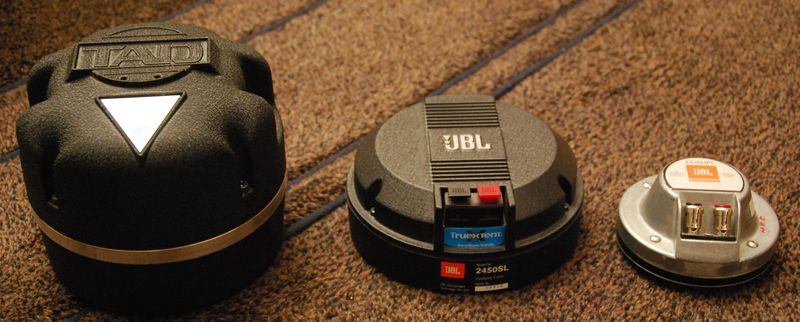
Above TAD 4003 vs 2450SL-Be (truextent) vs 2435HPL
(the JBL 476Be would be roughly the same size as the 2450SL-Be
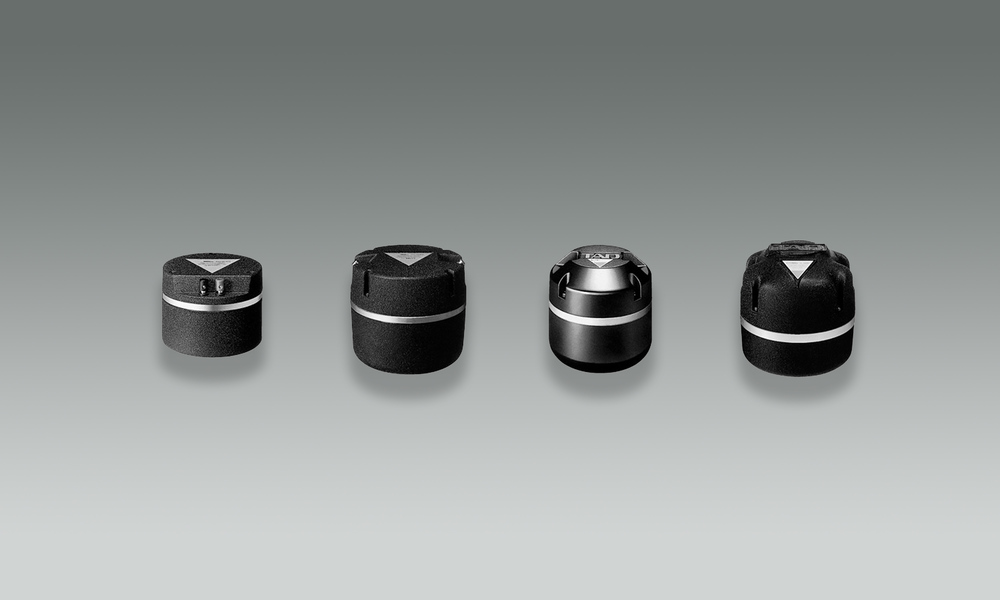
L to R, the TAD 2001, 4001, 2002, 4003
I will drop the details of the crossover and the specifics of the horns from this, as I don’t want to turn it into a DIY thread.
The details, planning, and execution behind the system
The source I heard the most at Leif was a Garrard, and normally I do not like Garrards because their wooden plinths usually color the sound and create a midbass bump. But Leif, typical to detail, does not have a normal Garrard. It’s a Garrardzilla
A new metal chassis from CTC in UK, adjustments, vacuum injecting oil in motor sinter bearings and mechanical tweaking for reduced vibes and noise plus new PSU with A/C and frequency adjustment for lower motor noise. A new 13.5kg bronze platter and custom grease bearing from Stefano Bertoncello who writes the blog twoogoodears…his 301 version is called Garrardzilla and is based on the Shindo Garrard bearing. A new custom designed slate plinth from Shaun Daniels at PeakHifi in UK with two arm boards
Assembled by Jaap Pees of Hanze Hifi, NL, whom I have visited previously to compare the Schopper TD 124 and Garrard 401
Not that the details matter to those who are not into Garrards, but it is to show how Leif gets into depth, does R&D, and sources it from wherever he has to. This is just one of his turntables. More on that.
As I continue, you will see why Leif reminded me of some of the hifi stalwarts I previously visited – when I visited Mike, I realized that behind every query I asked him lay a lot of detail. He had looked at each nook and cranny of his room, worked on it for years, on his speaker positioning, changing power supplies of his Herzans and tweaking every tweak, every possible detail to lead to an ultra low noise floor and room acoustics for music to play effortlessly. OMA simply does not design artistic speakers – if you walk down their warehouse, every corner including the kitchen, bathroom, toilets, are designed to artistic beauty. The General does not simply clean or source originals – the details behind the process, as well as handling of the LP when it is removed from the jacket, is an art. You know you are dealing with experts, because no matter what you find out from them during a conversation, there are layers and layers beneath – it is not superficial, not on the surface. There is passion, research, and interest and expertise in that topic. I got that today with Leif too.
A brief cursory look at the rest of his system, which has layers and layers beneath:I looked at pics of how the bass horns were separated into two compartments to make them manageable, how 3 sides were of one thickness, but the fourth where the compartments would attach to each other, were thinner and with links built in during design. Showing a detailed planning and thought process.
The rear of the midbass and bass horns had calculated diaphragms with vents that would let out a rear wave, to balance the pressure in the chambers and making it an easy impedance load.
The JMLC horn is painted with Nextel to not have a smooth surface
Leif’s speaker is backed by a DIYed 300b amp with two power supplies and two output stages, each of the 4 blocks weighing 25kg. Separate transformers for each filament and 300b. The noise generated by his amp is 160 microvolt AC, which is f-ing low.
The phono is a DIY Thorsten Loesch design LCR with 4x E810F and 47kg choke input PSU designed by Borderpatrol/Gary Dews, separate power transformers for all 4 tube rectifiers
No electrolytic caps in the path. For both amp and phono, Black Gate caps, high quality resistors and capacitors from Audio Note and Mundorf Supreme. Crossovers have Duelund Cast, Mundorf Silver in oil, but an industry grade inductor coil, because after his experiments, that’s what he preferred
Thinking how he could improve his sound even further:
- Try another table, modern belt, with a linear tracker – oh wait, he has the Basis Ovation with the best linear tracker possible, an Air tangent, and the Lyra Titan. Just my luck it wasn’t set up that day, I will have to make another trip to hear it. But if anyone needs more resolution than what I heard on the Garrard, this is the source to go to.
- He could try other valves, such as 45s, 2a3, etc but this is where voicing and preference of the owner comes in. It is difficult to beat his power supply, and the grainless, continuous sound that he is getting through it. One could voice it to a different valves amp
- Altec 515s instead of JBL 2220? I think so, maybe I am biased because I own a quad, but the difference would be minor but would fit into the design
- The room is a big living room, but no treatment, natural sound. In this case, best to keep it that way.
Leif’s bass horn
Rune Skamstrad designed Leif’s bass horn. Rune is famous for designing subs for many clubs, and also tutored Bjorn Kolbrek, who got his PhD in horns and has co-authored “High Quality Horn Loudspeaker Systems”. Rune’s first speaker below
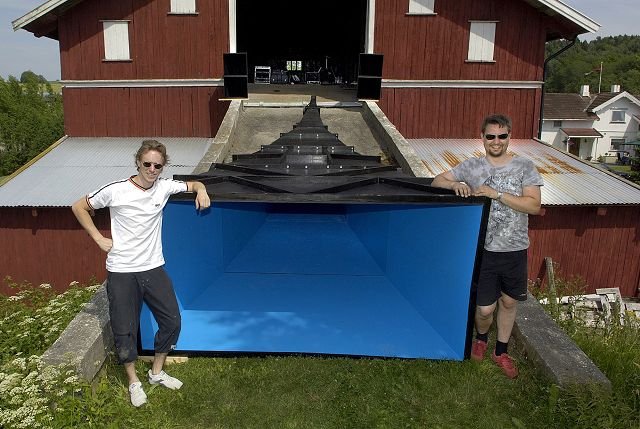
Leif’s bass horn below, 4 metres with a 21 inch 18 sound driver driven by a low pass filter at 75 hz going down to 15hz. 2 KVA power transformers in the amps driving this.
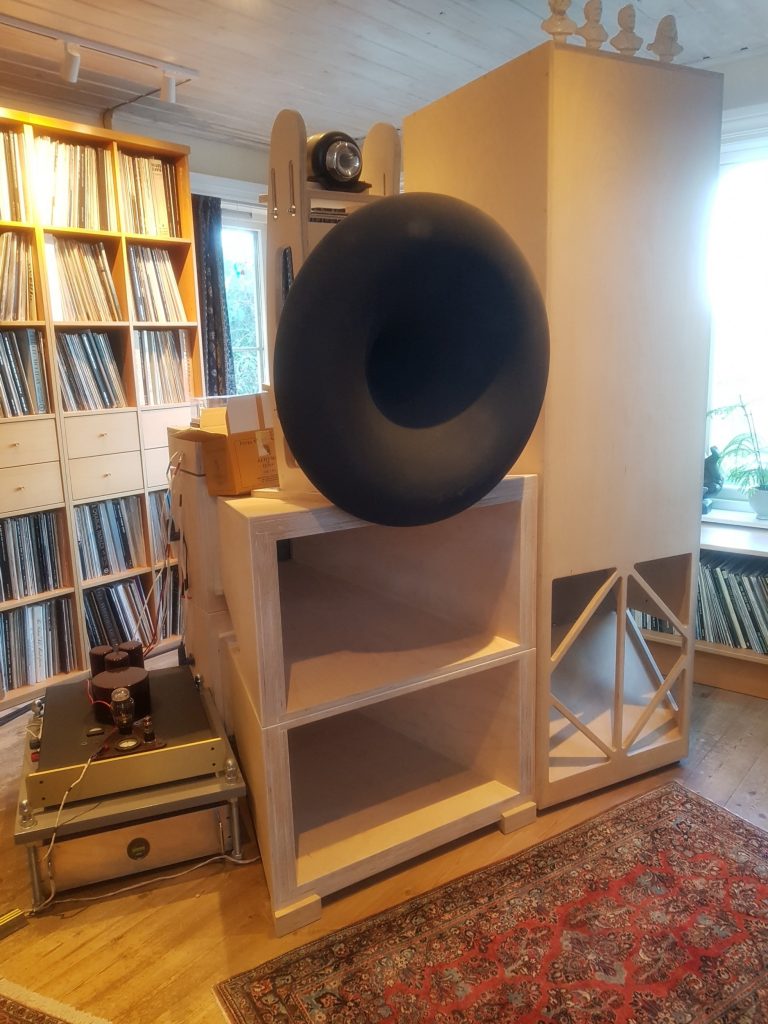
And here is a tape on Studer. He has 2 Studer A80 and one A810, modded by Mastertapesoundlab, one Studer 812, and a Studer A717 CD player.

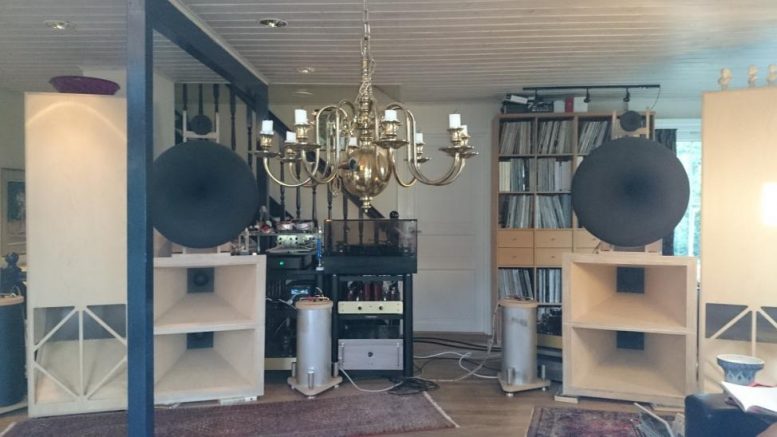
Hi, what changes of the diaphragm, suspension and the phase plug did he changed for the TAD 4003? My question is based from what you wrote ‘The 4003 had a change to the diaphragm and suspension and the speaker wire connected directly to the diaphragm. Both have 5 slit phase plugs but changes were made to the shape and material for 4003’